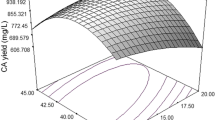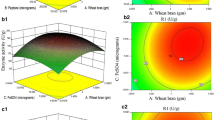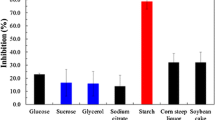Abstract
Response surface methodology (RSM) was employed to optimize medium components including oxygen vector of n-dodecane of a mutant strain GC-63 of Streptomyces roseosporus NRRL 11379. The two-level Plackett–Burman design (PB factorial design) with fourteen variables including oxygen vector was used to screen the most significant factors affecting antibiotic production. Then, the RSM based on center composite design was used to identify the optimum levels of the significant variables to generate optimal response. Glucose, soybean meal, asparagine and n-dodecane were screened to significantly influence the daptomycin production. The medium composition optimized with response surface methodology was (g/L): glucose, 9.46; soluble starch, 25; dextrin, 12.5; yeast extract, 12.5; soybean meal, 21.34; peptone, 25; casein, 5; asparagine, 2.68; K2SO4, 6; (NH4)2Fe(SO4)2, 2; MgSO4, 1; CaCO3, 5; MnCl2, 0.5; n-dodecane, 7.47 % (v/v). The maximum daptomycin concentration reached 979.36 mg/L which was nearly 2.2-fold higher compared to that in the basal medium, with predicted optimal concentrations in a 7.5-L fermentor.


Similar content being viewed by others
References
Steenbergen JN, Alder J, Thorne GM, Tally FP (2005) Daptomycin: a lipopeptide antibiotic for the treatment of serious Gram-positive infections. J Antimicrob Chemother 55:283–288
Piyushkumar M, Kiran D, Lele SS (2007) Application of response surface methodology to cell immobilization for the production of palatinose. Bioresour Technol 98:2892–2896
Chen H, Huang H, Wu H (2009) Process optimization for PHA production by activated sludge using response surface methodology. Biomass Bioenerg 33:721–727
Ghosh D, Hallenbeck PC (2010) Response surface methodology for process parameter optimization of hydrogen yield by the metabolically engineered strain Escherichia coli DJT135. Bioresour Technol 101:1820–1825
Xu F, Yuan QP, Zhu Y (2007) Improved production of lycopene and β-carotene by Blakeslea trispora with oxygen-vectors. Process Biochem 42:289–293
Yu GH, Jia XQ, Wen JP, Lu WY, Wang GY, Caiyin Q (2011) Strain Improvement of Streptomyces roseosporus for daptomycin production by rational screening of He–Ne laser and NTG induced mutants and kinetic modeling. Appl Biochem Biotech 163:729–743
Colombié V, Bideaux C, Goma G, Uribelarrea JL (2005) Effects of glucose limitation on biomass and spiramycin production by Streptomyces ambofaciens. Bioprocess Biosyst Eng 28:55–61
Wang JL (2000) Enhancement of citric acid production by Aspergillus niger using n-dodecane as an oxygen-vector. Process Biochem 35:1079–1083
Li Y, Jiang H, Xu Y, Zhang X (2008) Optimization of nutrient components for enhanced phenazine-1-carboxylic acid production by gacA-inactivated Pseudomonas sp. M18G using response surface method. Appl Microbiol Biotechnol 77:1207–1217
He L, Xu YQ, Zhang XH (2008) Medium factor optimization and fermentation kinetics for phenazine-1-carboxylic acid production by Pseudomonas sp. M18G. Biotechnol Bioeng 100:250–259
Acknowledgments
This work was supported by 21506048 and 51408396 from the National Natural Science Foundation of China. And the authors also wished to acknowledge the financial support provided by Excellent Talents Project of Henan University of Technology (2011BS037).
Author information
Authors and Affiliations
Corresponding author
Ethics declarations
Conflict of interest
The author declared that no potential conflict of interest existed in this study.
Rights and permissions
About this article
Cite this article
Yu, G., Wang, G. Optimization of the Biosynthesis Conditions of Daptomycin by the Biostatistical Methodology. Interdiscip Sci Comput Life Sci 9, 80–87 (2017). https://doi.org/10.1007/s12539-015-0133-8
Received:
Revised:
Accepted:
Published:
Issue Date:
DOI: https://doi.org/10.1007/s12539-015-0133-8




